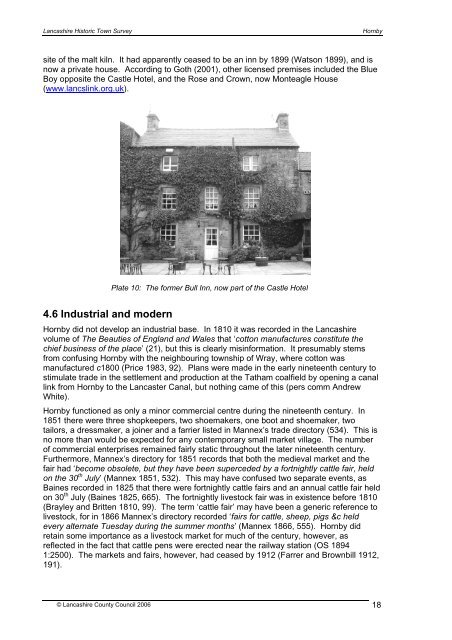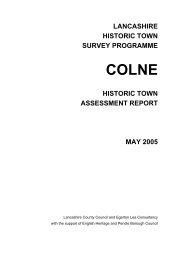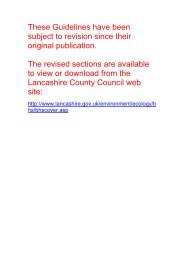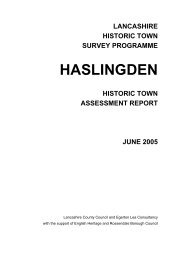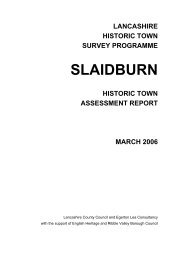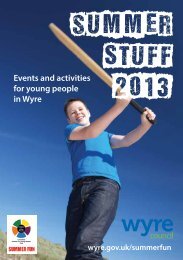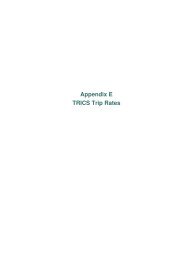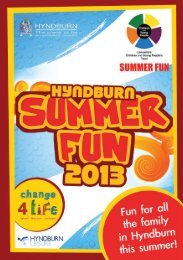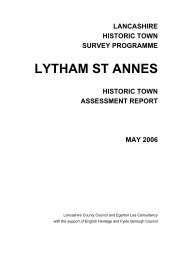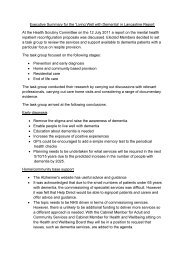HORNBY - Lancashire County Council
HORNBY - Lancashire County Council
HORNBY - Lancashire County Council
Create successful ePaper yourself
Turn your PDF publications into a flip-book with our unique Google optimized e-Paper software.
<strong>Lancashire</strong> Historic Town SurveyHornbysite of the malt kiln. It had apparently ceased to be an inn by 1899 (Watson 1899), and isnow a private house. According to Goth (2001), other licensed premises included the BlueBoy opposite the Castle Hotel, and the Rose and Crown, now Monteagle House(www.lancslink.org.uk).Plate 10: The former Bull Inn, now part of the Castle Hotel4.6 Industrial and modernHornby did not develop an industrial base. In 1810 it was recorded in the <strong>Lancashire</strong>volume of The Beauties of England and Wales that ‘cotton manufactures constitute thechief business of the place’ (21), but this is clearly misinformation. It presumably stemsfrom confusing Hornby with the neighbouring township of Wray, where cotton wasmanufactured c1800 (Price 1983, 92). Plans were made in the early nineteenth century tostimulate trade in the settlement and production at the Tatham coalfield by opening a canallink from Hornby to the Lancaster Canal, but nothing came of this (pers comm AndrewWhite).Hornby functioned as only a minor commercial centre during the nineteenth century. In1851 there were three shopkeepers, two shoemakers, one boot and shoemaker, twotailors, a dressmaker, a joiner and a farrier listed in Mannex’s trade directory (534). This isno more than would be expected for any contemporary small market village. The numberof commercial enterprises remained fairly static throughout the later nineteenth century.Furthermore, Mannex’s directory for 1851 records that both the medieval market and thefair had ‘become obsolete, but they have been superceded by a fortnightly cattle fair, heldon the 30 th July’ (Mannex 1851, 532). This may have confused two separate events, asBaines recorded in 1825 that there were fortnightly cattle fairs and an annual cattle fair heldon 30 th July (Baines 1825, 665). The fortnightly livestock fair was in existence before 1810(Brayley and Britten 1810, 99). The term ‘cattle fair’ may have been a generic reference tolivestock, for in 1866 Mannex’s directory recorded ‘fairs for cattle, sheep, pigs &c heldevery alternate Tuesday during the summer months’ (Mannex 1866, 555). Hornby didretain some importance as a livestock market for much of the century, however, asreflected in the fact that cattle pens were erected near the railway station (OS 18941:2500). The markets and fairs, however, had ceased by 1912 (Farrer and Brownbill 1912,191).© <strong>Lancashire</strong> <strong>County</strong> <strong>Council</strong> 2006 18


